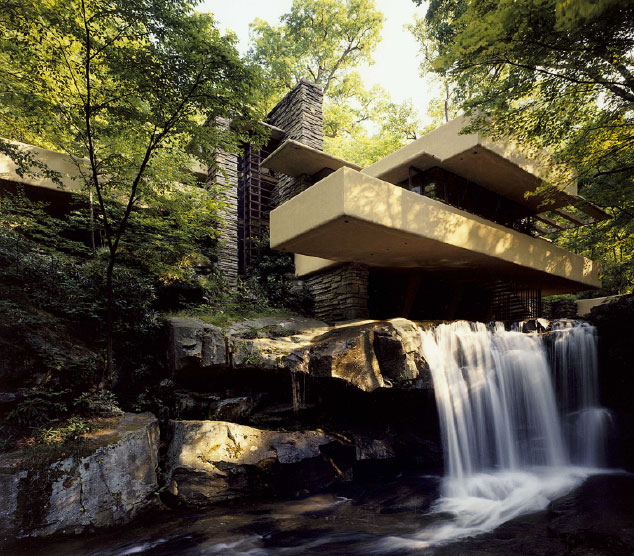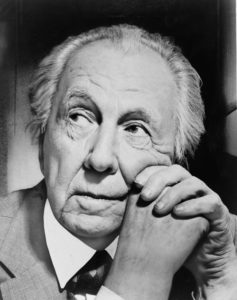Fallingwater
I. Nightrain
II. On the Level
III. Prairie Psalm
IV. Ahead of the Curve
Instrumentation: String quartet
Publisher: Michael Daugherty Music
Duration: 20 minutes
Program Note:
Fallingwater (2013) for string quartet is a musical tribute to the visionary American architect, Frank Lloyd Wright (1867-1959). The inspiration to compose this work came to me when I visited Taliesin, the 600-acre estate that Wright began to build in 1911, nestled into the rolling hills of Wisconsin. For over 40 years, Taliesin was his primary residence, studio, sanctuary, farm, school of architecture, and artistic statement to the world. In the main living hall, his third wife organized soirees for family, apprentices and renowned guests. As I stood in the center of this magnificent space, I noticed a large circular music stand made of wood, designed by Wright himself, with four sides for use by string quartets. I began to hear a composition for strings in four movements, as an emotional, spiritual, and musical exploration of Wright’s aesthetic of “organic architecture.”
Inspired by four of Frank Lloyd Wright’s most admired buildings—Taliesin, Fallingwater, Unity Temple and the Guggenheim Museum—I explore various dimensions of the string quartet in each movement of Fallingwater:
The first movement, “Night Rain,” is a nocturne that evokes the natural beauty of Wright’s beloved Taliesin (Welsh for “shining brow”). The plucking of strings, reverberating like drops of water falling softly at night, gradually transforms into a soaring lyrical theme first uttered by the first violin. Hearkening back to Wright’s Welsh ancestry, this theme grows organically and contrapuntally into a field of tonal cluster chords, played by the entire string ensemble.
“On the Level,” the second movement, is a scherzo inspired by Wright’s fanciful masterpiece, “Fallingwater.” Designed for the Kaufmann family and built between 1936 and 1939, this famous house is dramatically positioned over a waterfall in rural Pennsylvania. For this movement, I construct musical motives in rising and falling lines, creating multiple layers in various canons and tempos, like the daring cantilevers of Wright’s architectural structure.
The third movement, “Prairie Psalm,” is my musical meditation on the Unity Temple in Chicago, completed in 1909 when Wright was founding the Prairie School of architectural design. His architecture sought to unite people, buildings and nature in spatial and spiritual harmony. “I believe in God, only I spell it Nature,” he wrote. In this movement, I compose a space for reflection and repose through gradual development of meditative melody and heavenly harmonies. I also reflect on a passage from Ralph Waldo Emerson, often quoted by Wright: “Every spirit builds itself a house; and beyond its house, a world; and beyond its world, a heaven.”
“Ahead of the Curve,” the fourth movement, is inspired by the Guggenheim Museum, which was designed by Wright as his last masterpiece. Opening to great acclaim in New York in 1959, six months after his death, this virtuosic building was a dramatic finale to a long life of success, scandal, exile, tragedy, and perseverance. Wright struggled against his critics of the Guggenheim Museum, many of whom considered him out of step with their “modernist” aesthetic. But Wright proved to be ahead of the curve, reconfiguring space to bring art and people together in new ways. In composing the fourth movement, I recreate the feeling of walking through the spiraling design of the museum, with the first violin always one step ahead of the ensemble. Like the Guggenheim Museum and the city surrounding it, my music is in perpetual motion, ahead of the curve.
–Michael Daugherty


